Andrea Solari (1460–1524) was an Italian Renaissance painter of the Milanese school. He was initially named Andre del Gobbo, but more confusingly as Andrea del Bartolo a name shared with two other Italian painters, the 14th Century Siennese Andrea di Bartolo, and the 15th Century Florentine Andrea di Bartolo.

Vincenzo Foppa was an Italian painter from the Renaissance period. While few of his works survive, he was an esteemed and influential painter during his time and is considered the preeminent leader of the Early Lombard School. He spent his career working for the Sforza family, Dukes of Milan, in Pavia, as well as various other patrons throughout Lombardy and Liguria. He lived and worked in his native Brescia during his later years.

The Madonna of the Book, or the Madonna del Libro, is a small painting by the Italian Renaissance artist Sandro Botticelli, and is preserved in the Poldi Pezzoli Museum in Milan. The painting is executed in tempera on panel. It dates from between 1480 and 1483.
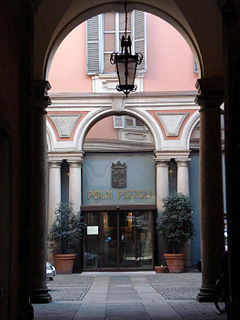
The Museo Poldi Pezzoli is an art museum in Milan, Italy. It is located near the Teatro alla Scala, on Via Manzoni 12.
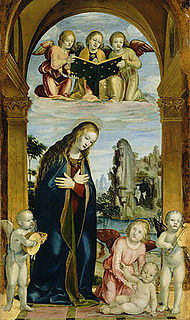
BernardoZenale was an Italian painter and architect.
The Bagatti Valsecchi Museum is a historic house museum in the Montenapoleone district of downtown Milan, northern Italy.

Giampietrino, probably Giovanni Pietro Rizzoli, was a north Italian painter of the Lombard school and Leonardo's circle, succinctly characterized by Sidney J. Freedberg as an "exploiter of Leonardo's repertory."

Via Manzoni, is a busy and fashionable street in the Italian city of Milan which leads from the Piazza della Scala north-west towards Piazza Cavour. Notable buildings include the Museo Poldi Pezzoli, the elegant Grand Hotel et de Milan, which was the place of Giuseppe Verdi’s death in 1901, and several fine palazzi. Via Manzoni was originally called Corsia del Giardino before the crossroad with Via Monte Napoleone and Corso di Porta Nuova up until Piazza Cavour.

Villas and palaces in Milan are used to indicate public and private buildings in Milan of particular artistic and architectural value. Milan has always been an important centre with regard to the construction of historical villas and palaces, ranging from the Romanesque to the neo-Gothic, from Baroque to Rococo.
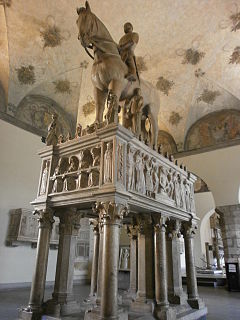
The Museo d'Arte Antica is an art museum in the Castello Sforzesco of Milan, in Lombardy in northern Italy. It has a large collection of sculpture from the late antiquity, Mediaeval and Renaissance periods. The various frescoed rooms of the museum house an armoury, a tapestry room, some funerary monuments, the Rondanini Pietà and two mediaeval portals.

Giovanni Ambrogio Bevilacqua, also known as il Liberale Bevilacqua was an Italian painter active in Lombardy in a late-medieval or early Renaissance style. He was a pupil of Vincenzo Foppa of Milan.
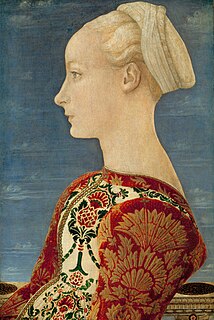
Profile Portrait of a Young Lady is a 1465 half-length portrait, made with oil-based paint and tempera on a poplar panel. It is held by the Gemäldegalerie in Berlin, which describes this work as one of its most famous paintings, and as one of the most famous portraits of women from the early Italian Renaissance.

Gian Giacomo Poldi Pezzoli was an Italian count who gathered art from Italian Renaissance and left Italy one of the first private museum which bears his name, the Museo Poldi Pezzoli.

The following outline is provided as an overview of and topical guide to Milan:

The Poldi Pezzoli Madonna or Madonna with the Sleeping Christ Child is a tempera on canvas painting by Andrea Mantegna, dating to around 1490-1500, after the painter's trip to Rome. It was bought from Giovanni Morelli's collection by Gian Giacomo Poldi Pezzoli shortly after the 1850s and is now in the Museo Poldi Pezzoli in Milan. It was restored in 1863 by Giuseppe Molteni, who added the varnish which has now yellowed.
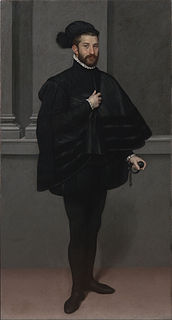
The Knight in Black is a c.1567 oil on canvas portrait painting of an unknown male subject by Giovanni Battista Moroni, now in the Museo Poldi Pezzoli in Milan.
The Saint Augustine Altarpiece was a mixed-technique 1454-1469 panel painting by Piero della Francesca, now split up and dispersed. It had at least ten panels, not including a probable predella or other panels. Eight panels survive.

The Pra della Valle in Padua is a 1741-1746 oil on canvas painting of the Prato della Valle in Padua by Canaletto. It entered the collection of the Milanese nobleman Gian Giacomo Poldi Pezzoli and from there it passed its present owner, the Museo Poldi Pezzoli in Milan.



















